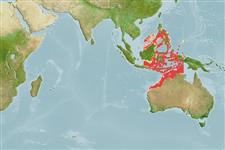>
Eupercaria/misc (Various families in series Eupercaria) >
Nemipteridae (Threadfin breams, Whiptail breams)
Etymology: Parascolopsis: Greek, para in the side of + Greek, skolos = stake + Greek, ops = appearance (Ref. 45335).
Environment: milieu / climate zone / depth range / distribution range
Écologie
marin démersal; non migrateur; profondeur 40 - 250 m (Ref. 58018). Tropical; 15°N - 23°S, 111°E - 135°E (Ref. 3810)
Western Pacific: including the Philippines, eastern Indonesia and northwestern Australia.
Taille / Poids / Âge
Maturity: Lm ? range ? - ? cm
Max length : 21.0 cm SL mâle / non sexé; (Ref. 3810); common length : 15.0 cm SL mâle / non sexé; (Ref. 3810)
Épines anales 3; Rayons mous anaux: 7. Body color is pinkish, darker on the back, grading to silvery ventrally. Four dark brownish-pink saddles are on the back, and a pale lemon-yellow stripe is on either side of ventral midline running from the base of the pelvic fins to the base of the caudal fin. The area between the eyes is greenish yellow. A pale mauve stripe joins the eyes through the nostrils.
Occurs offshore. Feeds mainly on benthic invertebrates.
Life cycle and mating behavior
Maturité | Reproduction | Frai | Œufs | Fécondité | Larves
Russell, B.C., 1986. Two new species of Parascolopsis (Piseces: Nemipteridae) from North-western Australia, Indonesia and the Philippines. Beagle, Occas. Pap. North. Territ. Mus. Arts Sci. 3(1):137-142. (Ref. 9923)
Statut dans la liste rouge de l'IUCN (Ref. 130435)
Menace pour l'homme
Harmless
Utilisations par l'homme
Pêcheries: pêcheries vivrières
Plus d'informations
Noms communsSynonymesMétabolismePrédateursÉcotoxicologieReproductionMaturitéFraiRassemblement de ponteFéconditéŒufsDéveloppement de l'œuf
RéférencesAquacultureProfil d'aquacultureSouchesGénétiqueElectrophoresesHéritabilitéPathologiesTraitementNutrientsMass conversion
CollaborateursImagesStamps, Coins Misc.SonsCiguateraVitesseType de nageSurface branchialeOtolithesCerveauxVision
Outils
Articles particuliers
Télécharger en XML
Sources Internet
Estimates based on models
Preferred temperature (Ref.
123201): 20.5 - 27.8, mean 25.2 °C (based on 127 cells).
Phylogenetic diversity index (Ref.
82804): PD
50 = 0.5002 [Uniqueness, from 0.5 = low to 2.0 = high].
Bayesian length-weight: a=0.01479 (0.00706 - 0.03101), b=2.97 (2.80 - 3.14), in cm total length, based on LWR estimates for this (Sub)family-body shape (Ref.
93245).
Niveau trophique (Ref.
69278): 3.5 ±0.37 se; based on food items.
Résilience (Ref.
120179): Haut, temps minimum de doublement de population inférieur à 15 mois (Preliminary K or Fecundity.).
Fishing Vulnerability (Ref.
59153): Low vulnerability (16 of 100).
